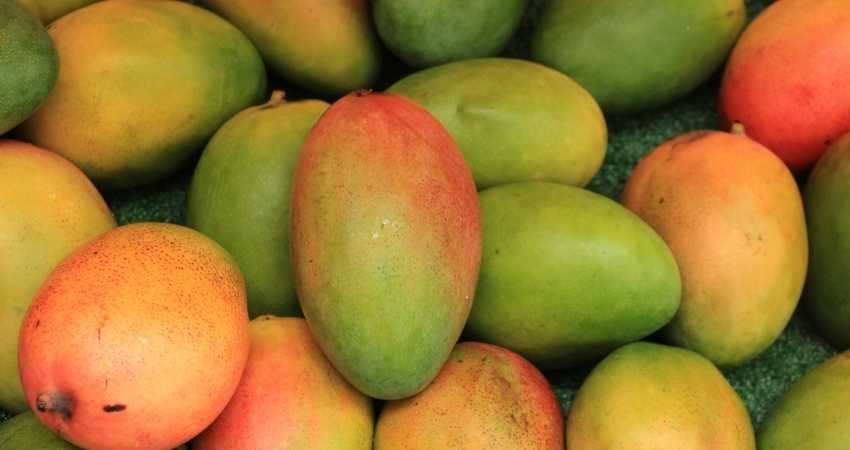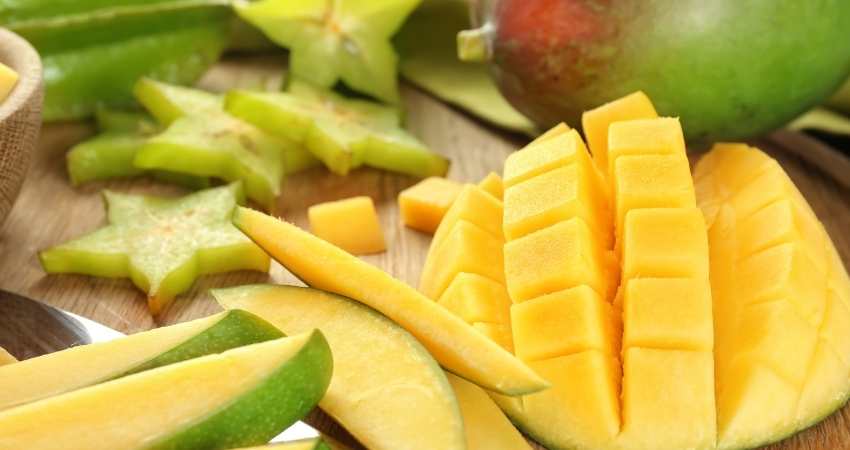The Best Way To Store Your Mangoes
For the best flavor and texture you should store mangoes until they reach the peak of ripeness. But what is the best way to store mangoes?
How to store mangoes:
- Store unripe mangoes on the counter until ripe.
- Store ripe mangoes in the refrigerator up to one week.
- Peel, cube and freeze unripe mangoes unused after one week.
As a consumer, you want to know how to judge the degree of ripeness the mangoes have reached before buying them. We will explore how to know when a mango is at its peak and how to store them throughout each ripening stage.

How To Store Mangoes
As a Certified Health Coach many clients ask me about food storage including mangoes. Therefore, I have researched this topic in the past and present. I also consume and store my own mangoes at home. Let’s examine the methods closely.
The degree of ripeness determines which of the three storage methods you will use1. Therefore, examine the mango you brought home from the store to determine if it’s ripe. You may be wondering, how do I know if a mango is ripe?
To know if a mango is ripe use the following three methods:
- Squeeze the mango: Give it a slight squeeze by pressing on it gently with your fingers. If it gives in and a dent appears, it’s ripe.
- Smell the mango: Smell it where the stem was. If it is ripe, it will have an intense, sweet aroma.
- Visually inspect the mango: A ripe mango has flesh around the stalk appearing firm. The stem should protrude outward. The color while be brighter and intense but this alone cannot determine the ripeness.
The color alone cannot determine the ripeness of a mango because the color varies according to the mango type ((Fruits & Veggies: Mango)). Check down further in this article to read more about the different colors.
I wrote an article dedicated to just mango ripening. Check out the article for ripening tips and find out if they can be ripened after peeling. You can read more by clicking here, The Complete Guide To Mango Ripening.
1. Store Unripe Mangoes on the Counter Until Ripe

If the mangos you brought home do not pass the test for ripeness, store them at room temperature to ripen.
If you need them to ripen quickly, store them in a closed paper bag. Check them each day, so they don’t over ripen. If you have several, only place two per bag.
Place the bag into a kitchen cabinet as long as it’s room temperature. This process may take two or three days depending on the ripeness2.
To speed up the ripening process even more, place a banana or an apple into the bag with the mango. Some fruits like apples and bananas produce ethylene gas3. This causes fruit to ripen faster.
In addition, some fruit is more sensitive to ethylene than others, and mangoes are one of them. Other ethylene producing fruit include the following:
- Avocados
- Cantaloupe
- Kiwi
- Peaches
- Pears
Don’t place an unripe mango into a sealed container instead of a paper bag. This slows down the ripening process and the mango will not ripen properly. The container is truly airtight while the paper bag material allows the mangoes to breath.
Disclaimer: Some links in this article are affiliate links which means I may earn a small commission at no extra cost to you. As an Amazon associate I earn from qualifying purchases.
Outdoor Mango Tip: While hiking, I take organic dried mangos with me as a great snack and easier than bringing a whole fruit. They offer a wide variety on Amazon which are affordable. Check them out by clicking here, Organic Dried Mangos.
2. Store Ripe Mangoes In The Refrigerator
If the mangoes are ripe when you buy them at the store, or the under-ripe mangoes have ripened, you’ll want to slow the ripening process. Slowing down the process helps prevent them from rotting before you get a chance to use them.
Slow the ripening process by storing the ripe mangoes in the refrigerator. They’ll hold their flavor and texture for up to five days. If you leave the ripe mangoes sitting out at room temperature, they will continue to ripen and soften ((University of California: Mango Ripening)).
While mangoes still ripen when in the fridge, it’s not a good idea to place unripe ones in there. Mangoes ripened more slowly in the refrigerator don’t taste as good as ones that ripened at room temperature.
Can You Store Mangoes In the Fridge?
Store ripe mangoes in the fridge, as it keeps them fresher until you’re ready to use them. If you’re not going to use them within a week, peel and cube them to store in the freezer.
3. Peel, Cube and Freeze Unused Mangoes
When ripe mangoes are ready to go bad, you have three options. Eat them, discard them or freeze them so you can keep them longer. I’m assuming you’re not going to throw them away unless they’ve already turned bad. Therefore, let’s find out how to freeze mangoes.
This is how to freeze mangoes:
- Peel the mango.
- Determine the size of the portions for future use.
- Cut it into chunks, slices or cubes.
- Space the pieces out onto a baking sheet lined with parchment paper. Make sure the pieces aren’t touching each other.
- Place the baking sheet into the freezer until the pieces freeze.
- Transfer the pieces into plastic freezer bags.
- Remove as much excess air from the bag as possible.
- Date the freezer bag and store it in the freezer up to six months.
It’s possible to puree the mango before freezing. You may decide to do this because it was already used for another purpose or your future use requires it to be pureed.
How to freeze pureed mangoes:
- If the mango is not pureed already, cut it into small chunks.
- Place the chunks into a blender or food processor.
- Puree until the mango is smooth.
- Pour the pureed mango into freezer safe food containers.
- Date the container and place it into the freezer for up to six months.
How To Defrost Frozen Mangoes
Defrost mangoes by following one of the two methods:
- Remove the frozen mango from the freezer and place it into the refrigerator until it thaws out. Allow this process to take place over night.
- If you’re in a hurry, fill a pot with lukewarm water and place the frozen container into the water. Keep the pot on the counter until it thaws.
How To Maintain The Nutritional Value of Mangoes While Storing
While waiting for the mangoes to ripen, always keep them out of sunlight and away from a heat source like the stove. If it is cut up, store it in an airtight container and keep it inside the refrigerator.
Mango Color and Ripeness/Storage
The most common colors for mangoes are yellow, red, and orange/goldish. Some are red with yellow shades or yellow with red shades. In addition, there are completely yellow or completely red mangoes when they are ripe.
There should never be green on a ripe mango. If the ones you’re storing have a fair amount of green coloring, it means it hasn’t ripened yet. While color is an indicator of ripeness, it’s not as important as the feel4.
Yellow mangoes start out green then gradually change to yellow as they ripen. But not all of them change color when being stored. This is because color defines the kind of mango, not the stage of ripeness ((USDA: Mangos)).
Hundreds of varieties of mangoes are grown throughout the world5. However, the six varieties listed below are those most commonly found in the supermarkets.
- Honey: These are yellow mangoes which are small, flat oblongs.
- Haden: These are red which have medium to large ovals.
- Keitt: Dark green with a pink blush with a large oval shape.
- Kent: Dark green with a small, dark, red blush in a large oval shape.
- Francis: Defined by bright yellow skin, green overtones and an oblong or S shape.
- Tommy Atkins: Dark red blush with green, orange and yellow accents. They might be oval or oblong and medium to large.
The Honey mango is the sweetest and softest with no fibers, while Haden are the original from which all other varieties descended.
Except for the Honey, mangoes have a degree of firmness which is determined by the amount of fiber in each.
In Other Countries, Mangoes Can Be Stored On The Tree
For those living in India, East Asia or South America, mango trees are a common sight and the fruit is plentiful6. Once the tree blossoms, the fruit will be ready to harvest within 150 days. Mango trees are evergreens and have been known to produce fruit at 300 years old.
It’s safe to say that the trees are a highly sustainable source of nutrition.
If you have any questions to ask me about this article don’t hesitate to comment below or email us. You can find an email on our contact page.
Read Next – More Food Storage Articles!
Can Almond Milk Be Frozen? Find Out Here
How To Store Wheat The Proper Way
- Mango.org: Ripening And Storing Mangos In A Few Easy Steps [↩]
- SFGATE: Stage of Maturity for Mangoes [↩]
- University of San Diego: Ethylene in Fruits and Vegetables [↩]
- Mango.org: Get To Know Your Mango [↩]
- Mango.org: Mango Varieties and Availability [↩]
- Mango.org: Mango Facts [↩]
